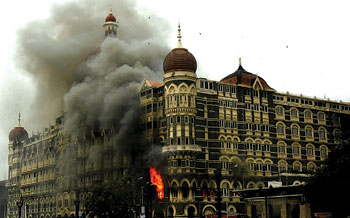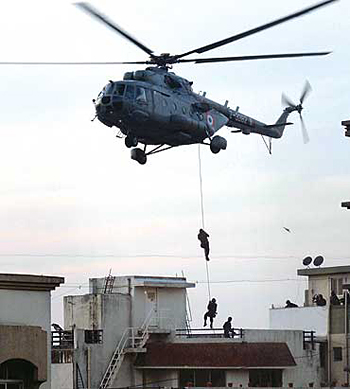INDIAN ARMED FORCES CHIEFS ON
OUR RELENTLESS AND FOCUSED PUBLISHING EFFORTS

SP Guide Publications puts forth a well compiled articulation of issues, pursuits and accomplishments of the Indian Army, over the years

I am confident that SP Guide Publications would continue to inform, inspire and influence.

My compliments to SP Guide Publications for informative and credible reportage on contemporary aerospace issues over the past six decades.
- Interim Defence Budget 2024-25 — An Analysis
- Union Defence budget 2024
- Indian Army: In quest of greater firepower and policy recommendations for gaps
- Indian Army Annual Press Conference 2024
- 6G will transform military-industrial applications
- Tata Boeing Aerospace Delivers 250 AH-64 Apache Fuselages, Manufactured in India
Lessons from 26/11 — what have we learned?
 |
By Lt. General P.C. Katoch Former Director General of Information Systems, Indian Army |


NSG Commandos beginning the assault on Nariman House by fast-roping onto the terrace.
Many would question what have we learned from the 26/11 Mumbai terrorist attacks that created Mayhem and created national uproar in 2008? A cartoon in the media shows a Mumbai policeman still without bulletproof jacket, helmet and carrying a stick instead of a weapon even on the eve of 26/11 despite a deluge of intelligence tip offs from multiple agencies of possible terror attack. For the weapon part, not all policemen are supposed to carry one. Post 26/11, Maharashtra raised a special anti-terrorism force, Force 1, which is based at Mumbai.
NSG too has established in Mumbai, while the MARCOS is already there and latter had come into play in 2008. However, the issue is whether the Force 1 and NSG have ever exercised together for counter-terrorism, as also with MARCOS. There doesn't appear to be any evidence about this. The NSG hub too reportedly is some 20 per cent short against the sanctioned strength of officers, which affects leadership required at times of crisis. The rapid expansion in NSG to metros of Mumbai, Chennai and Kolkata resulted in officer shortages because the Army that traditionally mans the Special Action Groups (SAGs) refused to provide additional officers because of its own shortfall. The vessel used by the terrorists during 2008 sailed from Karachi to Mumbai undetected and unchallenged. Many measures were supposed to have been out in place to avoid repeat of such incident.
However on October 6, MV Avant Garde was boarded by the Sri Lankan Navy and found to be carrying a cargo of more than 816 automatic rifles of different types and 2,02,674 rounds of ammunition. The discovery has sounded a security alarm as the vessel, before being rested at the Galle harbour in eastern Sri Lanka, had been to the Indian territorial waters while carrying its cargo of weapons. Police forces in States haven't grown or been modernized. Mumbai has the same numbers of personnel as in 2006 despite having been proved inadequate during 26/11. Efforts to expand police forces to the 220 police per 1,00,000 population norm advocated by the United Nations are nowhere near realization. The police-population ratio has risen only modestly but their equipping and modernization remains in poor state. The National Intelligence Grid (NATGRID) too was planned in the aftermath of 26/11. It is to provide the integrated intelligence grid connecting databases of core security agencies of Government of India to collect comprehensive patterns of intelligence that can be readily accessed by intelligence agencies. NATGRID is intended to enable the monitoring of terrorist operations through existing banking, finance and transportation, hasn't yielded to a single prosecution. It faced opposition on charges of possible violations of privacy and leakage of confidential personal information.
Its efficacy in preventing terror was also questioned given that no state agency or police force has access to its database thus reducing chances of immediate, effective action. However, these fears were countered on grounds that NATGRID would be protected by several structural and procedural safeguards and oversight mechanisms including that of external audits and technology safeguards. Conceived in 2010-11 and to be implemented in four phases (Horizon 1 to Horizon 4) NATGRID had not been able to complete even Horizon 1 by May 2015, though it was supposed to operationalize both Horizon 1 and 2 by 2014 at a cost of Rs1100 crore. Stuck in a time warp for nearly four years, the Modi government has decided to revitalize and re-infuse the NATGRID, which is an attached office of MHA and is presently engaged with the National Institute of Smart Government (NISG) to identify individuals for employment at NATGRID. The NATGRID reloaded instead of a standalone institution that was to be placed under an overarching umbrella of the national counter terror centre (NCTC), shelved subsequently amid stiff opposition from the States, will now be under the overall supervision of the Intelligence Bureau. As for the NCTC, it was perhaps required a decade back and is vital now with increasing threats to internal security. On assuming charge, the present government had said that the NCTC will be looked into, but no initiative has been taken in this regard. This needs to be given priority assuaging apprehensions of States by incorporating suitable measures. We actually require State level SCTCs duly linked to the NCTC through the NATGRID to ensure passage of intelligence real time / near real time intelligence at the operative end.





